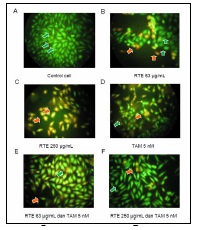Anti cancer activity of rodent tuber (Thyphonium flagelliforme (lodd.) Blume on human breast cancer t47d cells
Keywords:
Rodent tuber (Thyphonium flagelliforme (Lodd.) Blume), anti cancer, chemoprevention, T47D cellsAbstract
The incidence of breast cancer in developing countries showed an increase from year to year. The efforts of cancer prevention or treatment of the more important given the frequency of occurrence is quite high. Several studies have been focuses on natural products as agents of cancer chemoprevention and as co-chemotherapy agent against cancer. One of medicinal plant that is widely used as anticancer is rodent tuber (Thyphonium flagelliforme (Lodd.) Blume). In present study, we investigated the anticancer acitivty of rodent tuber extract (RTE) in vitro. Study of anti-proliferative conducted on human breast cancer primary T47D cells. Furthermore, the present study also investigated the molecular mechanisms of cell cycle arrest and induction of apoptosis. The study of rodent tuber as co-chemotherapy is determined by examining the effects on T47D and its combination with tamoxifen (TAM). The results showed the cytotoxic effects of RTE on T47D cells with IC50 value of 632 μg/mL. Low concentration RTE (below 250 ug/mL) are proliferative, while the concentration above 250 μg/mL indicated cytotoxic effect. Based on the calculation of Combination Index (CI), combination of RTE with TAM yielded a value above 10 indicated a strong antagonistic effect. In observation of apoptosis, low concentration of RTE (63 µg/mL) stimulate apoptosis better than high concentration of 250 μg/mL. However, the combination study with 5 nM TAM reduced the induction of apoptosis. Furthermore, the observation cell cycle arrest by flowcytometry, demonstrated that RTE 63 and 250 μg/mL increase the population of sub G1 phase respectively from 14.8% to 53.19 and 32.90%. These results suggest that RTE able to induce cell cycle to apoptosis, but low concentration of RTE more effective than high concentration. Similar to apoptosis observation, the combination of RTE and TAM also demonstrated the antagonistic effect by reducing the population of Sub-G1 RTE (63 μg/mL) and TAM 5 nM, respectively from 53.19% and 44.50% to 35.86%. All finding results of this study provide information that the use of rodent tuber extract (RTE) alone is better than the combination with TAM. In addition, the use of RTE together with TAM reduced the effectiveness of TAM in the treatment of breast cancer.
References
Singletary K, MacDonald C, Lovinelli M,
Fisher C, Wallig M. Effect of the betadiketones diferuloylmethane (curcumin) and
dibenzoylmethane on rat mammary DNA
adducts and tumors induced by 7,12-
dimethylbenz[a]anthracene, Carcinogenesis.
;9(6):1039–1043.
Yaar M, Eller MS, Panova I, Kubera J, Wee
LH, Cowan KH, Gilchrest BA. Telomeric
DNA induces apoptosis and senescence of
human carcinoma cells, Breast Cancer
Research. 2007;9:R13.
Choo CY, Chan KL, Sam TW, Hitotsuyanagi
Y, Takeya K. The cytotoxicity and chemical
constituents of the hexane fraction of
Thyponium flagelliformae (Araceace). J
Ethnopharmacol. 2001;77:129–131.
Lai CS, Mas RH, Nair NK, Majid MI,
Mansor SM, Navaratnam V. Thyponium
flagelliformae inhibits cancer cell growth in
vitro and induced apoptosis: an evaluation by
the bioactivity guided approach. J.
Ethnopharmacol. 2008;118:14–20.
Peterson G, Barnes S. Genistein inhibition of
the growth of human breast cancer cells:
independence from estrogen receptors and the
multi-drug resistance gene. Biochem Biophys
Res Commun. 1991;179:661–667.
Pagliacci MC, Smacchia M, Migliorati G,
Grignani F, Riccardi C, Nicoletti I. Growthinhibitory effects of the natural phytoestrogen
genistein in MCF-7 human breast cancer
cells. Eur J Cancer. 1994;30A(11):1675–
Hsieh CY, Santell RC, Haslam SZ and
Helferich WG. Estrogenic effects of genistein
on the growth of estrogen receptor-positive
human breast cancer (MCF-7) cells in vitro
and in vivo. Cancer Res. 1998;58:3833–3838.
Shao ZM, Shen ZZ, Fontana JA, Barsky SH.
Genistein’s “ER-dependent and independent”
actions are mediated through ER pathways in
ER-positive breast carcinoma cell lines.
Anticancer Res. 2000;20:2409–2416.
Zava DT, Duwe G. Estrogenic and
antiproliferative properties of genistein and
other flavonoids in human breast cancer cells
in vitro. Nutr Cancer. 1997;27:31–40.
Fioravanti L, Cappelletti V, Miodini P,
Ronchi E, Brivio M, Di Fronzo G.
Genistein in the control of breast cancer
cell growth: insights into the mechanism of
action in vitro. Cancer Lett. 1998;130:143–
Cuzick J, Forbes J, Edwards R, Baum M,
Cawthorn S, Coates A, Hamed A, Howell
A, Powles T; IBIS investigators. First
results from the International Breast Cancer
Intervention Study (IBIS-I): A randomised
prevention trial. Lancet 2002;360:817–824.
Powles T, Eeles R, Ashley S, Easton D,
Chang J, Dowsett M, Tidy A, Viggers J,
Davey J. Interim analysis of the incidence
of breast cancer in the Royal Marsden
Hospital tamoxifen randomized
chemoprevention trial. Lancet.
;352:98–101.
Veronesi U, Maisonneuve P, Costa A,
Sacchini V, Maltoni C, Robertson C,
Rotmensz N, Boyle P. Prevention of breast
cancer with tamoxifen: Preliminary
findings from the Italian randomized trial
among hysterectomised women. Lancet.
;352:93–97.
Cuzick J, Powles T, Veronesi U, Forbes J,
Edwards R, Ashley S, Boyle P. Overview
of the main outcomes in breast-cancer
prevention trials. Lancet.2003;361:296–
Verma SP, Goldin BR, Lin PS. The
inhibition of the estrogenic effects of
pesticides and environmental chemicals by
curcumin and isoflavonoids, Environ
Health Perspect 1998;106:807–812.
Fisher B, Dignam J, Bryant J, DeCillis A,
Wickerham DL, Wolmark N, Costantino J,
Redmond C, Fisher ER, Bowman DM,
Deschênes L, Dimitrov NV, Margolese RG,
Robidoux A, Shibata H, Terz J, Paterson
AH, Feldman MI, Farrar W, Evans J,
Lickley HL. Five vs more than five years of
tamoxifen therapy for breast cancer patients
with negative lymph nodes and estrogen
receptorpositive tumors. J. Natl Cancer
Inst. 1996;88:1529–1542.
Fisher B, Costantino JP, Wickerham DL,
Redmond CK, Kavanah M, Cronin WM,
Vogel V, Robidoux A, Dimitrov N, Atkins J,
Daly M, Wieand S, Tan-Chiu E, Ford L,
Wolmark N. Tamoxifen for prevention of
breast cancer: report of the National Surgical
Adjuvant Breast and Bowel Project P-1 Study.
J Natl Cancer Inst 1998;90:1371–1388.



